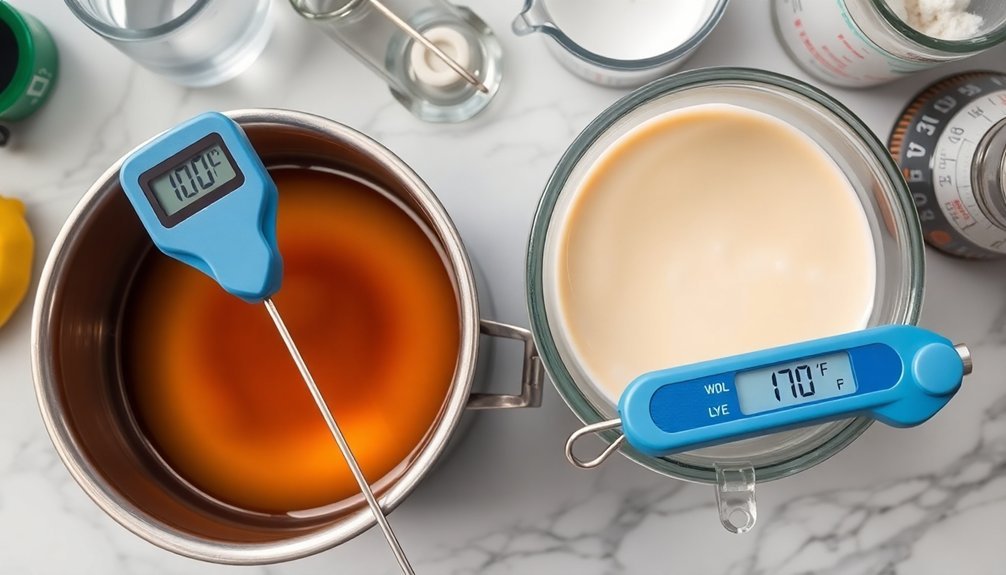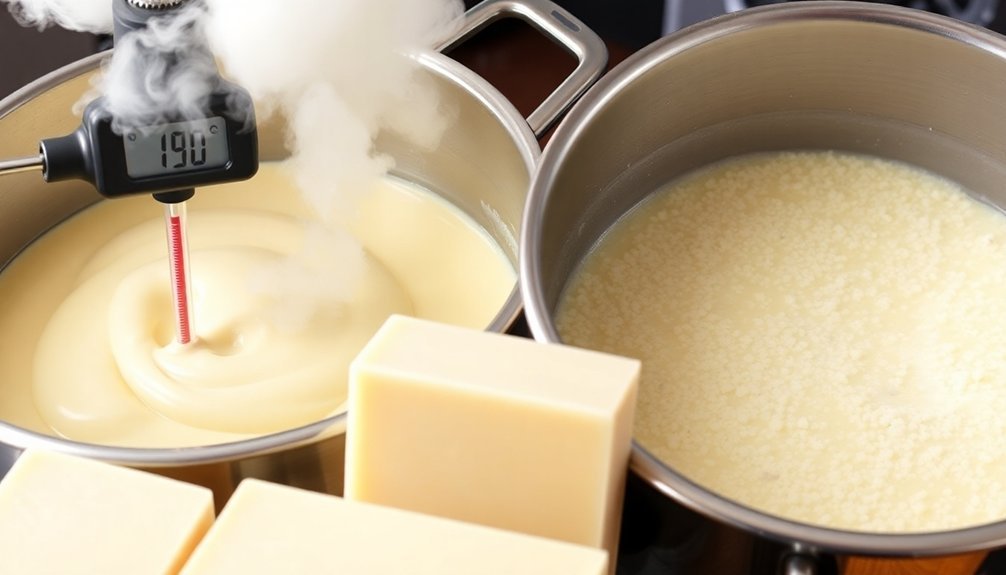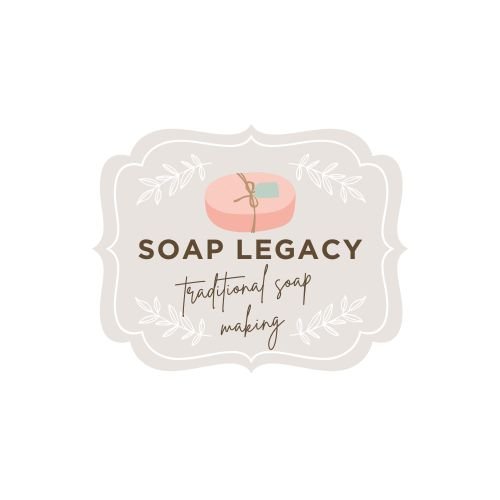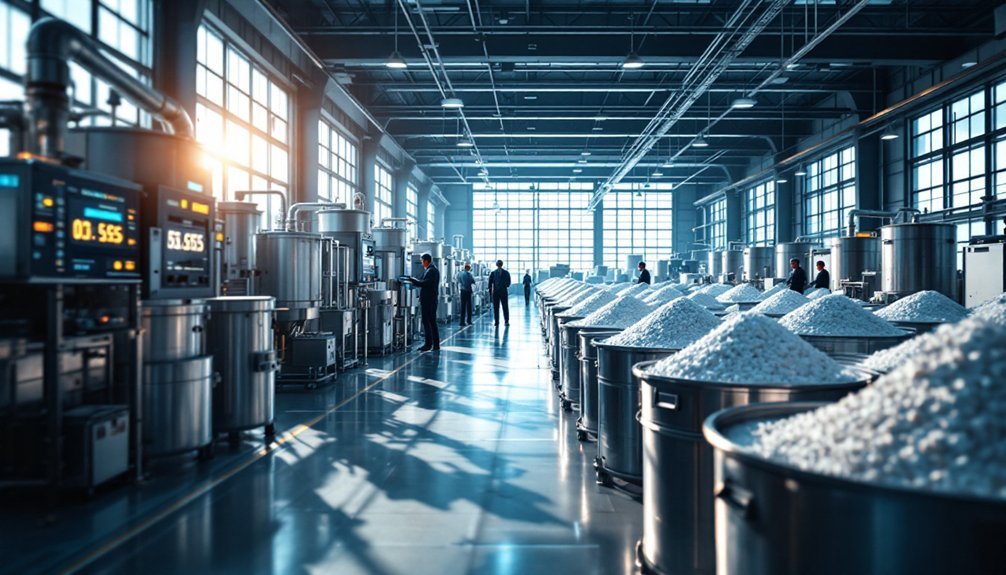Soap making requires strict temperature control (120-130°F) because it directly affects the saponification process. When your oils and lye are at proper temperatures, you'll achieve better emulsion, prevent false trace, and avoid common defects like soda ash or glycerin rivers. Temperature management also impacts color vibrancy, fragrance retention, and overall soap quality. In cooler or warmer months, you'll need specific adjustments to maintain consistent results. Master these temperature guidelines and watch your soaping success improve dramatically.
Why Must Soap Making Follow Strict Temperature Guidelines?

When crafting homemade soap, temperature control isn't just a suggestion—it's a necessity for success. Maintaining oils and lye within the ideal 120-130°F range guarantees proper saponification reaction and prevents common pitfalls that can ruin your batch.
If your oils aren't fully melted and homogenized, you'll risk false trace—where the soap batter appears ready but actually contains solidified fats. This leads to soap defects and poor quality bars.
Remember, your lye solution can reach 200°F initially, but must cool before mixing with oils to prevent immediate solidification.
Proper temperature management during cold process soap making also helps prevent soda ash formation on your soap's surface. Using the heat transfer method—adding hot lye to warm oils—can enhance the saponification process and help achieve a successful gel phase in your finished product.
The Science Behind Saponification and Temperature Control

The chemical reaction that transforms your oils and lye into soap accelerates or slows dramatically based on temperature variations as small as 10°F.
You'll notice that maintaining precise temperatures between 120-130°F creates the ideal environment for proper emulsion formation, preventing issues like false trace or separation.
When your lye solution and oils meet at compatible temperatures, you're controlling not just the reaction rate but also ensuring the molecular structure develops correctly for a smooth, consistent final product.
Reaction Rate Factors
Behind every successful batch of handmade soap lies a complex chemical reaction known as saponification, where temperature control plays a crucial role in determining your final product's quality. The reaction rate between your oils and lye solution depends heavily on temperatures maintained throughout the process.
- Temperature differential – Keep your oil and lye solution temperatures within 10 degrees of each other to prevent incomplete saponification or soda ash formation.
- Heat threshold – The ideal 120-130°F range guarantees oils fully melt while preventing premature thickening of soap mixture.
- Acceleration factors – Higher temperatures accelerate reaction rates, potentially triggering gel phase which enhances colors.
- Lye heating – Your lye solution can reach 200°F during mixing but should cool to around 120-130°F before combining with oils to guarantee smooth incorporation.
Emulsion Stability Control
Understanding the science behind temperature's effect on emulsion stability can dramatically improve your soap-making results. When your lye solution and oils stay within 10 degrees of each other (ideally 120-130°F), they blend smoothly, creating a stable emulsion essential for proper saponification.
Temperature control prevents false trace—a premature thickening that occurs when solidified fats appear to react with lye but haven't actually undergone complete saponification. This phenomenon compromises soap quality, resulting in inconsistent texture and potentially undissolved lye.
Higher temperatures accelerate the chemical reaction in hot process soap making, promoting stable emulsions and faster trace development. Conversely, cooler temperatures can impede saponification, leading to soda ash formation and textural issues.
Critical Temperature Ranges for Cold Process Soap Making

When crafting successful cold process soap, maintaining proper temperature control becomes essential for achieving a smooth, predictable reaction. The ideal soaping temperature range of 120-130°F guarantees proper saponification while preventing false trace issues that can ruin your batch.
For best results:
- Keep your lye solution and oil mixture temperatures within 10 degrees of each other to create a stable emulsification.
- Verify oils appear completely clear before mixing, as cloudiness indicates solidified fatty acids.
- Cool your lye solution to approximately 120-130°F before combining with oils to prevent accelerated reactions.
- Thoroughly melt all hard oils within the recommended temperature range to avoid premature solidification.
Following these temperature guidelines helps you maintain control over the saponification process and produces consistently successful batches of cold process soap.
Hot Process Temperature Requirements and Monitoring

While cold process soap requires careful temperature management, hot process soap making demands even more precise heat control throughout its accelerated cooking phase.
Unlike cold process, you'll want to melt your oils in the cooking pot first, then add hot lye solution directly—no cooling necessary. This approach jumpstarts the saponification reaction.
Maintain a temperature range of 131-160°F to promote the gel phase, which enhances color vibrancy and prevents soda ash formation.
You must monitor temperatures vigilantly to prevent overheating, which can trigger soap volcanoes or create glycerin rivers in your final product.
The benefit? The heat-accelerated saponification reaction greatly reduces cure time, meaning your hot process soap will be ready to use much sooner than cold process varieties.
Preventing False Trace: Temperature's Role in Oil Consistency

Because temperature directly affects oil viscosity, it plays an essential role in preventing false trace during the soap making process. When your oils and lye solution aren't at proper temperatures, you'll likely encounter premature thickening that resembles trace but actually indicates incomplete saponification.
To prevent false trace and achieve a smoother and more consistent final product:
- Maintain oils at the ideal soaping temperature of 120-130°F to guarantee they're fully melted and homogenized.
- Keep your lye solution around body temperature or slightly higher.
- Verify oils are clear without cloudiness before combining ingredients.
- Remember that mixing must continue until saponification generates heat to remelt any solidified fats.
Proper temperature management throughout the process helps avoid the grainy appearance that results when solidified fats prematurely thicken your soap batter.
The Heat Transfer Method: Balancing Lye and Oil Temperatures
The Heat Transfer Method offers a resourceful approach for soap makers who want to simplify temperature management. By capitalizing on the high heat (approximately 200°F) generated by your lye solution, you'll effectively melt your oils without additional heating equipment. This technique works particularly well with softer or liquid oils that respond quickly to heat.
For successful saponification, keep your lye solution and oils temperatures within 10 degrees of each other. This proximity prevents issues like false trace while promoting thorough integration of ingredients. Stir gently until all oils completely melt before you begin blending to trace—this guarantees proper homogenization of your mixture.
The Heat Transfer Method not only streamlines your process but ultimately yields a more consistent soap product with fewer temperature-related complications, making it an excellent technique for both beginners and experienced crafters.
Temperature-Related Defects: Glycerin Rivers and Alien Brain
When temperatures surge beyond 130°F during the soap-making process, you're likely to encounter two common aesthetic defects: glycerin rivers and alien brain.
These temperature-related defects can ruin your soap's appearance and texture, turning a potentially beautiful creation into a disappointing result.
To prevent these issues through proper temperature management:
- Monitor your soap mixture closely, keeping both oils and lye within the 120-130°F range.
- Watch for signs of overheating during saponification, which often triggers the alien brain effect.
- Reduce heat immediately if your soap begins developing lumpy, bumpy surfaces.
- Control environmental factors like room temperature and insulation that might contribute to glycerin rivers.
Hard Oils vs. Liquid Oils: Different Temperature Needs
When making soap, you'll need to account for the different melting points between hard oils like coconut and palm (120-130°F) and liquid oils like olive and sunflower that remain fluid at room temperature.
These temperature variations directly impact how easily you can form a proper emulsion, with hard oils requiring complete melting to avoid false trace or graininess in your final product.
Keeping your oils and lye solution within 10 degrees of each other guarantees ideal conditions for saponification, especially vital in recipes with high percentages of hard oils.
Melting Point Differences
Understanding the diverse melting points of soap-making oils is essential for achieving consistent results in your finished product. Each oil behaves differently when exposed to heat, requiring thoughtful temperature management throughout your soap-making process.
- Hard oils like coconut oil (melts at 76°F) and cocoa butter (melts at 93-101°F) need temperatures between 120-130°F to fully incorporate into your soap mixture.
- Insufficient melting of hard oils can cause them to solidify when they contact lye, creating grainy soap texture and uneven saponification.
- Liquid oils such as olive oil and sunflower oil don't require significant heating since they remain fluid at room temperature.
- Proper temperature control helps you achieve ideal trace consistency and prevents common issues like false trace, where the mixture appears ready but actually contains unmelted hard oil particles.
Emulsion Forming Temperatures
Since successful soap-making relies heavily on proper emulsion formation, controlling your oils' temperatures becomes a vital factor in the process. Your hard oils and butters, like coconut oil, require higher melting temperatures (120-130°F) to fully incorporate into your soap batter, while liquid oils can be used at room temperature.
For ideal saponification, maintain both your oils and lye temperatures within the 120-130°F range. This guarantees they're within 10 degrees of each other—a significant requirement for achieving a smooth emulsion.
When temperatures aren't properly balanced, you'll face issues like false trace, clumping, or separation during mixing. Insufficient heating of hard oils results in grainy texture and poor soap quality.
Managing Soaping Environment Temperature for Success
As you commence your soap making journey, controlling the temperature of your soaping environment becomes paramount to achieving consistent, high-quality results.
Maintaining temperatures between 120-130°F guarantees proper saponification and prevents false trace when oils solidify prematurely.
Your temperature choices directly impact your soap's characteristics:
- Cool temperatures (100-110°F) prevent gel phase, ideal when working with milk or juice additives.
- Hot temperatures (131-160°F) promote vibrant colors and reduce soda ash formation.
- Mold selection affects temperature retention—wooden molds retain heat better than silicone alternatives.
- Insulation techniques like cooling racks or placing soap in cooler areas help manage temperature consistently.
Remember that significant temperature differences between oils and lye risk incomplete saponification, compromising your soap's quality and consistency.
How Temperature Affects Color Development and Additive Performance
Temperature plays a critical role in determining your soap's color vibrancy, with the gel phase (131-160°F) enhancing hues while cooler temperatures (100-110°F) preventing unwanted color changes.
You'll find that maintaining ideal temperatures between 120-130°F provides the best environment for colorants to develop fully while ensuring a smooth mixture without false trace issues.
Be mindful that heat-sensitive additives like essential oils and certain fragrance components require specific temperature thresholds to maintain their potency and effectiveness throughout the saponification process.
Color Vibrancy Management
Three key factors determine how vibrant your soap colors will appear: temperature, oil selection, and additive timing. Managing soaping temperature is essential for achieving consistent, vibrant colors throughout your soap making process.
- Heat promotes vibrancy – Maintaining 120-130°F encourages gel phase, which enhances color intensity, especially when using heat-responsive colorants like LabColors.
- Cooler temperatures (100-110°F) help prevent glycerin rivers while preserving fragrance oils that might otherwise overheat and affect color.
- Oil choices matter – Coconut oil generates additional heat during saponification, potentially darkening your soap if temperatures aren't carefully monitored.
- Citrus essential oils require lower temperature management as they lose both scent and color vibrancy when exposed to excessive heat.
Following these temperature guidelines helps you control color development while maintaining the integrity of your soap's appearance.
Additives' Temperature Thresholds
Every additive in soap making has its specific temperature sweet spot where it performs best. Understanding these thresholds can dramatically improve your soap's final appearance and performance.
For instance, LabColors work effectively between 131-160°F, enhancing color vibrancy, especially when you want to encourage gel phase for brighter hues.
Your essential oils, however, demand cooler temperatures. Citrus oils in particular can lose their fragrance when exposed to excessive heat during saponification. Working at cold process temperatures (100-110°F) helps preserve scents while preventing glycerin rivers and soda ash formation.
Don't overlook your oils' melting points either. Maintaining proper oil temperature (120-130°F) guarantees hard butters fully melt, preventing false trace that can compromise additive distribution.
Thermometer Selection and Temperature Testing Methods
Selecting the right thermometer is perhaps the most critical tool decision you'll make in your soap making journey. Digital thermometers provide the most accurate temperature readings, guaranteeing your lye and oil temperatures stay within 10 degrees of each other—essential to avoid false trace during the saponification process.
When testing temperatures for precise measurements, follow these guidelines:
- Choose thermometers with a 0-200°F range to accommodate all soap making temperature needs.
- Fully submerge thermometer probes in your mixtures for accurate readings.
- Check both lye solution and oils separately before combining.
- Calibrate your thermometers regularly to maintain accuracy.
Remember that surface temperatures can be misleading—proper testing guarantees your entire mixture is at the ideal temperature, directly impacting your soap's quality and consistency.
Adjusting Temperatures for Special Ingredients and Milk Soaps
While standard soap recipes tolerate a wide temperature range, special ingredients like milk and certain fragrance oils demand more precise temperature control.
When working with milk soaps, you'll need to lower your soaping temperature to 100-110°F to prevent scorching. This cooler environment protects milk from developing unpleasant brown spots or curdling during saponification.
For your lye solution, consider using cold milk instead of warm to maintain lower temperatures throughout the process.
This precaution is particularly important when incorporating fragrance oils that generate significant heat, which can accelerate trace and make your soap batter difficult to manage.
Seasonal Temperature Variations and Their Impact on Soap Making
As the seasons change, so do the challenges in your soap making process. Seasonal temperature variations considerably affect the saponification process, requiring you to adapt your techniques throughout the year to maintain consistent soap quality.
During cooler months:
- Keep oil and lye temperatures between 120-130°F to prevent premature thickening.
- Consider wooden molds for their heat retention properties to promote gel phase.
- Monitor ambient temperatures in your workspace, as cold rooms can cause false trace.
- Adjust lye concentrations slightly to compensate for slower reactions.
In warmer weather, you'll face opposite challenges—potential overheating can cause soap volcanoes and glycerin rivers.
Using plastic molds during summer helps reduce heat retention, while refrigeration or cooling racks can prevent soap from overheating when temperatures soar.
Frequently Asked Questions
How Important Is Temperature in Soap Making?
Temperature is critical in your soap making process. You'll achieve proper saponification at 120-130°F, preventing false trace, oil solidification, and soda ash. It'll also influence gel phase, enhancing color and ensuring smooth texture.
What Is the Effect of Temperature on the Saponification Reaction?
Temperature directly controls your saponification speed. When it's too high, you'll get accelerated reactions causing gel phase or defects. Too low, and you'll face incomplete saponification, false trace, and soda ash formation.
Why Do You Need to Be Careful When Making Soap?
You need to be careful when making soap because you're working with caustic lye that can cause chemical burns. You'll also need precise measurements and temperature control to guarantee safe, successful saponification.
What Happens if Cold Process Soap Gets Too Hot?
If your cold process soap gets too hot, you'll risk gel phase problems like alien brain formation, soap volcanoes, glycerin rivers, and soda ash. It's why you should maintain consistent temperatures throughout the process.
In Summary
You'll find that following temperature guidelines isn't just about procedure—it's essential for successful saponification. When you maintain proper temperatures, you're ensuring oils and lye combine correctly, preventing false trace, and preserving the integrity of colorants and additives. Your thermometer becomes your most trusted tool, helping you adapt to seasonal changes and special ingredients. Master temperature control, and you'll transform your soap making from unpredictable to consistently professional.





Leave a Reply